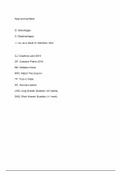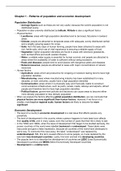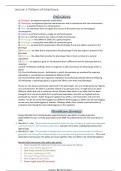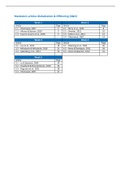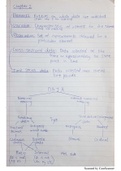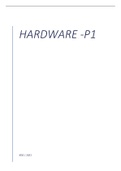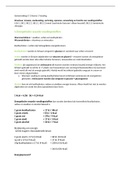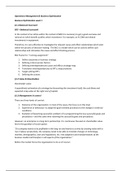𝑃𝑟𝑒 𝐶𝑎𝑙𝑐𝑢𝑙𝑢𝑠 → 𝐿𝑖𝑚𝑖𝑡 𝑝𝑟𝑜𝑐𝑒𝑠𝑠 → 𝐶𝑎𝑙𝑐𝑢𝑙𝑢𝑠
Chapter Two – Limits and Their properties
2.1
Average rate of change to instant rate of change
Slope of a line to slope of a curve
Area under a curve
Work done by variable force
Mass of a solid of variable density
Surface area of a solid of revolution
Tangent line problem
The secant lines of two points, P and Q, on a curve get infinitely closer to the limit, the tangent line
Find equation of the tangent line to the graph at point P
Secant Line – a line through the point of tangency and a second point on the curve
Finding a tangent line at point P is equal to finding the slope of the tangent line at P.
𝑓(𝑐 + ∆𝑥) − 𝑓(𝑐)
𝑚𝑠𝑒𝑐 =
∆𝑥
Area Problem
Bound an area under a curve
Use segmented rectangles to find area
2.2
When using a limit, we are approximating the closest point on a graph to the limit.
Intro to Limits
lim 𝑓(𝑥) = 𝐿
𝑥→𝑐
1. Numerical (Table of Values)
2. Graphical (Draw or use calculator)
3. Analytical (Algebra or Calculus)
Limits that do not exist
f(x) approaches a different number from right side of c than it does from the left
f(x) increases or decreases without bound as x approaches c
f(x) oscillates between two fixed values as x approaches c
A weird limit - Dirichlet function
0, 𝑖𝑓 𝑥 𝑖𝑠 𝑟𝑎𝑡𝑖𝑜𝑛𝑎𝑙
𝑓(𝑥) = {
1, 𝑖𝑓 𝑥 𝑖𝑠 𝑖𝑟𝑟𝑎𝑡𝑖𝑜𝑛𝑎𝑙
Function has no limit at any real number c, it is not continuous at any real number c.
Left hand limit is where lim− 𝑓(𝑥)
𝑥→𝑎
Right hand limit is where lim− 𝑓(𝑥)
𝑥→𝑎
,Formal Definition of a Limit
The 𝜺 − 𝜹 definition of a limit
Let f be a function defined on an open interval containing c (except possibly at c), and let L be a real
number. The statement
lim 𝑓(𝑥) = 𝐿
𝑥→𝑐
means that for each 𝜀 > 0 there exists a 𝛿 > 0 such that if
0 < |𝑥 − 𝑐| < 𝛿
then
|𝑓(𝑥) − 𝐿| < 𝜀
lim 𝑓(𝑥) = 𝐿. Implies two statements – the limit exists, and the limit is L.
𝑥→𝑐
Some functions do not have limits as x approaches c, but those that do cannot have two different limits
as x approaches c. That is, if the limit of a function exists, then the limit is unique.
To find 𝛿 𝑜𝑟 𝜀, relate the two inequalities from definition
Prove existence of a limit by proving that you can find a 𝛿 for any 𝜖.
1. Identify |𝑥 − 𝑎|
2. Evaluate |𝑓(𝑥) − 𝐿| and simplify until 𝑐|𝑥 − 𝑎|
𝜀
3. Choose 𝛿 = 𝑐
4. Summarize if |𝑥 − 𝑎| < 𝛿 then |𝑓(𝑥) − 𝐿| = ⋯ < 𝜀
For absolute values, isolate and then make other side + and – and solve for both values
MY TEXTBOOK
2.1
Average velocity – velocity over an interval of time
Instantaneous velocity – velocity at one point in time
Limit brings us closer and closer to what we are looking for
Use slope formula as your average speed or secant line
Continue to get closer to a when x approaches a
𝑠(𝑡) − 𝑠(1)
𝑚𝑡𝑎𝑛 𝑜𝑟 𝑣𝑖𝑛𝑠𝑡 = lim
𝑡→1 𝑡−1
Use given (x, f(x)) value as the x1 and values close to (x, f(x)) for x2 in slope form
Find equation of tangent with y =mx + b, plug in slope and x and y values
Cross out like terms
To find slope or instant speed make a general formula and simplify then using subbing in x value
Use given x value for x1 and then use f(x) to simplify
2.2
One-Sided Limits
Right-sided limit; Supposed f is defined for all x near a with x > a. If f(x) is arbitrarily close to L for all x
sufficiently close to a with x > a, we write
lim+ 𝑓(𝑥) = 𝐿
𝑥→𝑎
And say the limit of f(x) as a approaches a from the right equals L.
Left-sided limit; Suppose f is defined for all x near a with x < a. If f(x) is arbitrarily close to L for all x
sufficiently close to a with x < a, we write
lim− 𝑓(𝑥) = 𝐿
𝑥→𝑎
, And say the limit of f(x) as x approaches a rom the left equals L.
Theorem 2.1 Relationship Between One-Sided and Two-Sided Limits
Assume f is defined for all x near a except possibly at a. Then
lim 𝑓(𝑥) = 𝐿
𝑥→𝑎
If and only if
lim 𝑓(𝑥) = 𝐿
𝑥→𝑎 +
And
lim 𝑓(𝑥) = 𝐿
𝑥→𝑎 −
For graphs with jumps, make into a piecewise function by examining x values you can put into
denominator to make the absolute value + or –
f(x) approaches a different number from right side of c than it does from the left
f(x) increases or decreases without bound as x approaches c
f(x) oscillates between two fixed values as x approaches c
2.3
Limits of Linear Functions
Theorem 2.2 Limits of Linear Functions
Let a, b, and m be real numbers. For linear functions 𝑓(𝑥) = 𝑚𝑥 + 𝑏,
lim 𝑓(𝑥) = 𝑓(𝑎) = 𝑚𝑎 + 𝑏
𝑥→𝑎
Works because 𝑓(𝑥) approaches 𝑓(𝑎) when x approaches a from both sides of a
Theorem 2.3 Limit Laws
Assume lim 𝑓(𝑥) and lim 𝑔(𝑥) exist. The following properties hold, where c is a real number, and n > 0
𝑥→𝑎 𝑥→𝑎
is an integer.
1. Sum lim (𝑓(𝑥) + 𝑔(𝑥)) = lim 𝑓(𝑥) + lim 𝑔(𝑥)
𝑥→𝑎 𝑥→𝑎 𝑥→𝑎
2. Difference lim (𝑓(𝑥) − 𝑓(𝑔)) = lim 𝑓(𝑥) − lim 𝑔(𝑥)
𝑥→𝑎 𝑥→𝑎 𝑥→𝑎
3. Constant Multiple lim (𝑐𝑓(𝑥)) = 𝑐 lim 𝑓(𝑥)
𝑥→𝑎 𝑥→𝑎
4. Product lim (𝑓(𝑥)𝑔(𝑥)) = (lim 𝑓(𝑥)) (lim 𝑔(𝑥))
𝑥→𝑎 𝑥→𝑎 𝑥→𝑎
𝑓(𝑥) lim 𝑓(𝑥)
5. Quotient lim ( ) = 𝑥→𝑎 , provided lim 𝑔(𝑥) ≠ 0
𝑥→𝑎 𝑔(𝑥) lim 𝑔(𝑥)
𝑥→𝑎
𝑥→𝑎
𝑛 n
6. Power lim (𝑓(𝑥)) = (lim 𝑓(𝑥))
𝑥→𝑎 𝑥→𝑎
1 1
7. Root lim (𝑓(𝑥))𝑛 = (lim 𝑓(𝑥))𝑛 , provided 𝑓(𝑥) > 0, for all x near a, if n is even
𝑥→𝑎 𝑥→𝑎

